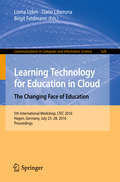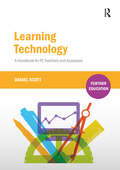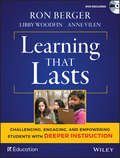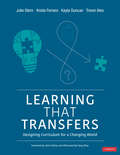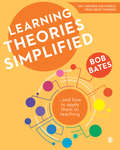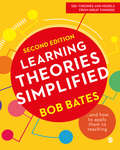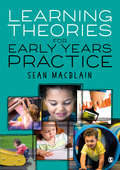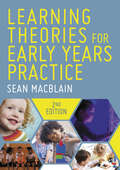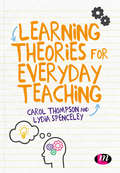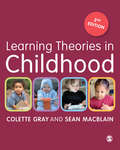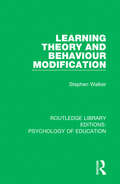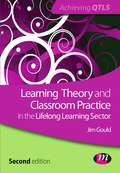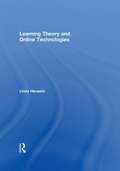- Table View
- List View
Learning Technology for Education in Cloud - The Changing Face of Education
by Lorna Uden Dario Liberona Birgit FeldmannThis book constitutes the refereed proceedings of the 5th International Workshop on Learning Technology for Education in Cloud, LTEC 2016, held in Maribor, Slovenia, in July 2016. The 25 revised full papers presented were carefully reviewed and selected from 51 submissions. The papers are organized in topical sections on learning technologies; learning tools and environment; MOOC for learning; problem solving and knowledge transfer; case study.
Learning Technology: A Complete Guide for Learning Professionals
by Donald ClarkLearning technology is now an integral part of all learning and development (L&D) activity. Understanding what these technologies are, how they work and their aims is key to successful L&D practice. Learning Technology is written by a leading voice in the learning tech industry with over 35 years' experience. It explains the history of learning tech, its aims, its introduction to the workplace and the benefits to both the individual and the business. This book covers everything from online and mobile learning, simulations and gamification as well as detailed discussion of Learning Management Systems (LMSs), Learning Experience Platforms (LXPs) and Learning Record Stores (LRSs). This book also highlights the importance of data and analytics and covers the latest developments in the learning technology space including artificial intelligence, virtual reality and the metaverse. Most importantly, Learning Technology helps L&D professionals assess where their budget is best spent on technology and explains how to analyse the return on investment (ROI). Full of examples and practical advice throughout, this book also includes case studies from organizations including British Airways, UK National Health Service (NHS) and Learning Pool.
Learning Technology: A Handbook for FE Teachers and Assessors (Further Education)
by Daniel ScottWritten specifically for all FE and post-16 teachers, this book will help you to develop your digital capabilities and give you the skills to convert traditional learning and teaching resources into engaging and interactive online material.The impact of the pandemic means that it is abundantly clear to all that digital capability is vital for learners, no matter what subject they study. You should therefore develop your digital capabilities as a basic competence in order to embrace current digital tools, apps and techniques to the pedagogy of teaching FE. The book provides you with the knowledge and skills required to source information learning technology (ILT) and content to convert traditional learning and teaching resources into engaging and interactive online material.It is designed around each aspect of the teaching and training cycle - identifying needs, planning and designing, delivering and facilitating, assessing and evaluating – and includes: when to use ILT / eLearning barriers to implementing digital learning the importance of digital capabilities ways of keeping up to date and continuing professional development.
Learning That Lasts: Challenging, Engaging, and Empowering Students with Deeper Instruction
by Jal Mehta Ron Berger Libby Woodfin Anne VilenA practical guide to deeper instruction--a framework for challenging, engaging, and empowering students of all ages For schools to meet ambitious new standards and prepare all students for college, careers, and life, research has shown unequivocally that nothing is more important that the quality of daily instruction. Learning That Lasts presents a new vision for classroom instruction that sharpens and deepens the quality of lessons in all subject areas. It is the opposite of a 'teacher-proof' solution. Instead, it is predicated on a model of instruction that honors teachers as creative and expert planners of learning experiences for their students and who wish to continuously grow in their instructional and content knowledge. It is not a theoretical vision. It is a model of instruction refined in some of the nation's most successful public schools--schools that are beating the odds to create remarkable achievement--sited primarily in urban and rural low-income communities. Using case studies and examples of powerful learning at all grade levels and in all disciplines, Learning That Lasts is a guide to creating classrooms that promote deeper understanding, higher order thinking, and student independence. Through text and companion videos, readers will enter inspiring classrooms where students go beyond basics to become innovators, collaborators, and creators. Learning That Lasts embraces a three-dimensional view of student achievement that includes mastery of knowledge and skills, character, and high-quality work. It is a guide for teachers who wish to make learning more meaningful, memorable, and connected to life, and inspire students to do more than they think possible.
Learning That Transfers: Designing Curriculum for a Changing World (Corwin Teaching Essentials)
by Julie Stern Krista Ferraro Kayla Duncan Trevor Aleo"It is a pleasure to have a full length treatise on this most important topic, and may this focus on transfer become much more debated, taught, and valued in our schools." - John Hattie Teach students to use their learning to unlock new situations. How do you prepare your students for a future that you can’t see? And how do you do it without exhausting yourself? Teachers need a framework that allows them to keep pace with our rapidly changing world without having to overhaul everything they do. Learning That Transfers empowers teachers and curriculum designers alike to harness the critical concepts of traditional disciplines while building students’ capacity to navigate, interpret, and transfer their learning to solve novel and complex modern problems. Using a backwards design approach, this hands-on guide walks teachers step-by-step through the process of identifying curricular goals, establishing assessment targets, and planning curriculum and instruction that facilitates the transfer of learning to new and challenging situations. Key features include Thinking prompts to spur reflection and inform curricular planning and design. Next-day strategies that offer tips for practical, immediate action in the classroom. Design steps that outline critical moments in creating curriculum for learning that transfers. Links to case studies, discipline-specific examples, and podcast interviews with educators. A companion website that hosts templates, planning guides, and flexible options for adapting current curriculum documents. Using a framework that combines standards and the best available research on how we learn, design curriculum and instruction that prepares your students to meet the challenges of an uncertain future, while addressing the unique needs of your school community.
Learning That Transfers: Designing Curriculum for a Changing World (Corwin Teaching Essentials)
by Julie Stern Krista Ferraro Kayla Duncan Trevor Aleo"It is a pleasure to have a full length treatise on this most important topic, and may this focus on transfer become much more debated, taught, and valued in our schools." - John Hattie Teach students to use their learning to unlock new situations. How do you prepare your students for a future that you can’t see? And how do you do it without exhausting yourself? Teachers need a framework that allows them to keep pace with our rapidly changing world without having to overhaul everything they do. Learning That Transfers empowers teachers and curriculum designers alike to harness the critical concepts of traditional disciplines while building students’ capacity to navigate, interpret, and transfer their learning to solve novel and complex modern problems. Using a backwards design approach, this hands-on guide walks teachers step-by-step through the process of identifying curricular goals, establishing assessment targets, and planning curriculum and instruction that facilitates the transfer of learning to new and challenging situations. Key features include Thinking prompts to spur reflection and inform curricular planning and design. Next-day strategies that offer tips for practical, immediate action in the classroom. Design steps that outline critical moments in creating curriculum for learning that transfers. Links to case studies, discipline-specific examples, and podcast interviews with educators. A companion website that hosts templates, planning guides, and flexible options for adapting current curriculum documents. Using a framework that combines standards and the best available research on how we learn, design curriculum and instruction that prepares your students to meet the challenges of an uncertain future, while addressing the unique needs of your school community.
Learning Theories Simplified: ...and how to apply them to teaching
by Bob BatesAre you struggling to get your head around John Dewey’s educational pragmatism? What exactly is Jean Piaget saying about cognitive development? Maybe you’re running out of time and patience making sense of Rosenshine′s Principles of Instruction? Have you reached breaking point reading Daniel T. Willingham on educational neuroscience? Written for busy teachers, students, trainers, managers and , this ′dip-in, dip-out′ guide makes theories of learning accessible and practical. It explores 134 classic and contemporary learning theorists in an easy-to-use, bite-sized format with clear relevant illustrations on how each theory will benefit teaching and learning. Each model or theory is explained in less than 350 words, followed by a ′how to use it′ section. New to this third edition: New section on cognitive learning theory, including Arthur Shimamura, Alison Gopnik, John Flavell and more Enhanced critical perspectives offering a deeper examination of each theory′s strengths and weaknesses A new entry on Gloria Ladson-Billings and Critical Race Theory in education
Learning Theories Simplified: ...and how to apply them to teaching
by Bob BatesAre you struggling to get your head around John Dewey’s educational pragmatism? What exactly is Jean Piaget saying about cognitive development? Maybe you’re running out of time and patience making sense of Rosenshine′s Principles of Instruction? Have you reached breaking point reading Daniel T. Willingham on educational neuroscience? Written for busy teachers, students, trainers, managers and , this ′dip-in, dip-out′ guide makes theories of learning accessible and practical. It explores 134 classic and contemporary learning theorists in an easy-to-use, bite-sized format with clear relevant illustrations on how each theory will benefit teaching and learning. Each model or theory is explained in less than 350 words, followed by a ′how to use it′ section. New to this third edition: New section on cognitive learning theory, including Arthur Shimamura, Alison Gopnik, John Flavell and more Enhanced critical perspectives offering a deeper examination of each theory′s strengths and weaknesses A new entry on Gloria Ladson-Billings and Critical Race Theory in education
Learning Theories Simplified: ...and how to apply them to teaching
by Dr Bob BatesAre you struggling to get your head around John Dewey's educational pragmatism? What exactly is Jean Piaget saying about cognitive development? Maybe you're running out of time and patience making sense of Carol Dweck's mindsets? Have you reached breaking point reading Daniel T. Willingham on educational neuroscience? Written for busy teachers, trainers, managers and students, this dip-in dip-out guide makes theories of learning accessible and practical. It explores over 100 classic and contemporary learning theorists in an easy-to-use, bite-sized format with clear relevant illustrations on how each theory will benefit your teaching and learning. Each model or theory is explained in less than 350 words, many with accompanying diagrams, and the 'how to use it' sections, in less than 500 words. Every entry includes: Do it steps in order to apply the theory or model Reflection points & challenges to develop your understanding of how to apply it Analogies & metaphors from which understanding and meaning can be drawn Tips for the classroom Further reading if you want to explore a theory in greater depth.
Learning Theories Simplified: ...and how to apply them to teaching
by Dr Bob BatesAre you struggling to get your head around John Dewey’s educational pragmatism? What exactly is Jean Piaget saying about cognitive development? Maybe you’re running out of time and patience making sense of Carol Dweck’s mindsets? Have you reached breaking point reading Daniel T. Willingham on educational neuroscience? Written for busy teachers, trainers, managers and students, this dip-in dip-out guide makes theories of learning accessible and practical. It explores over 100 classic and contemporary learning theorists in an easy-to-use, bite-sized format with clear relevant illustrations on how each theory will benefit your teaching and learning. Each model or theory is explained in less than 350 words, many with accompanying diagrams, and the ‘how to use it’ sections, in less than 500 words. Every entry includes: Do it steps in order to apply the theory or model Reflection points & challenges to develop your understanding of how to apply it Analogies & metaphors from which understanding and meaning can be drawn Tips for the classroom Further reading if you want to explore a theory in greater depth. More titles by Bob Bates: Educational Leadership Simplified A Quick Guide to Special Needs and Disabilities
Learning Theories Simplified: ...and how to apply them to teaching
by Dr Bob BatesWritten for busy teachers, trainers, managers and students, this 'dip-in, dip-out' guide makes theories of learning accessible and practical. It explores 130 classic and contemporary learning theorists in an easy-to-use, bite-sized format with clear relevant illustrations on how each theory will benefit teaching and learning. Each model or theory is explained in less than 350 words, followed by a 'how to use it' section. This second edition includes: • A new early childhood theorists section • A new communication theories section • Additional ‘on trend’ theorists throughout • New ‘critical view’ features added to each entry
Learning Theories Simplified: ...and how to apply them to teaching
by Dr Bob BatesWritten for busy teachers, trainers, managers and students, this 'dip-in, dip-out' guide makes theories of learning accessible and practical. It explores 130 classic and contemporary learning theorists in an easy-to-use, bite-sized format with clear relevant illustrations on how each theory will benefit teaching and learning. Each model or theory is explained in less than 350 words, followed by a 'how to use it' section. This second edition includes: • A new early childhood theorists section • A new communication theories section • Additional ‘on trend’ theorists throughout • New ‘critical view’ features added to each entry
Learning Theories for Early Years Practice
by Sean MacBlainUnderstanding and applying learning theories is crucial to the transition from study or training, to practice in a real-world setting. This new textbook will prepare the reader by demonstrating how key learning theories pan out in practice, with the aid of photographs, examples and clear explanations. Divided into three main sections, Early Influences, Modern Influences, and Challenges for Theorists in a Changing World, this author identifies the key theorists in early childhood, past and present, before linking them to the main issues and developments that face early years practitioners today. An explanation of each key theorist is guided by a clear structure, including: links to other theorists strengths and weaknesses of the theory the theory in practice Packed full of case studies, activities, points for discussion, extended and recommended reading, this is a fantastic resource for students and teachers who want to build a strong foundation in learning theories, to enable them to support the young children in their care as effectively as possible.
Learning Theories for Early Years Practice
by Sean MacBlainUnderstanding and applying learning theories is crucial to the transition from study or training, to practice in a real-world setting. This new textbook will prepare the reader by demonstrating how key learning theories pan out in practice, with the aid of photographs, examples and clear explanations. Divided into three main sections, Early Influences, Modern Influences, and Challenges for Theorists in a Changing World, this author identifies the key theorists in early childhood, past and present, before linking them to the main issues and developments that face early years practitioners today. An explanation of each key theorist is guided by a clear structure, including: links to other theorists strengths and weaknesses of the theory the theory in practice Packed full of case studies, activities, points for discussion, extended and recommended reading, this is a fantastic resource for students and teachers who want to build a strong foundation in learning theories, to enable them to support the young children in their care as effectively as possible.
Learning Theories for Early Years Practice
by Sean MacBlainThe perfect guide for students who need to get to grips with learning theories and how they relate to the early years, this book covers Early and Modern theorists and their theories, and how they apply today. Bursting with full colour photographs, case studies, activities and discussion points, each chapter explores the theorist and the theory; what the theory looks like in practice; the strengths and weaknesses of each theory; and its links to other theorists. This new edition includes: Three new chapters on Bowlby, Dweck and Claxton New reflective activities New critical questions following the case studies
Learning Theories for Early Years Practice
by Sean MacBlainThe perfect guide for students who need to get to grips with learning theories and how they relate to the early years, this book covers Early and Modern theorists and their theories, and how they apply today. Bursting with full colour photographs, case studies, activities and discussion points, each chapter explores the theorist and the theory; what the theory looks like in practice; the strengths and weaknesses of each theory; and its links to other theorists. This new edition includes: Three new chapters on Bowlby, Dweck and Claxton New reflective activities New critical questions following the case studies
Learning Theories for Early Years Practice
by Sean MacBlainThis third edition showcases captivating full-color photographs, compelling case studies, engaging activities, and thought-provoking discussion points. Each chapter delves into the theorist and the theory, illustrating their practical applications, strengths, weaknesses, and connections to other theorists. This indispensable resource empowers students to create inclusive learning environments. New to this edition: New chapter on Barbara Rogoff and children in cultural communities Expanded final section on theorists in the contemporary world, covering vital issues such as mental health, diversity, gender, special educational needs, play, valuing our environments, and artificial intelligence Updated case studies and examples
Learning Theories for Early Years Practice
by Sean MacBlainThis third edition showcases captivating full-color photographs, compelling case studies, engaging activities, and thought-provoking discussion points. Each chapter delves into the theorist and the theory, illustrating their practical applications, strengths, weaknesses, and connections to other theorists. This indispensable resource empowers students to create inclusive learning environments. New to this edition: New chapter on Barbara Rogoff and children in cultural communities Expanded final section on theorists in the contemporary world, covering vital issues such as mental health, diversity, gender, special educational needs, play, valuing our environments, and artificial intelligence Updated case studies and examples
Learning Theories for Everyday Teaching
by Carol Thompson Lydia SpenceleyAn essential tool for new teachers and trainees who want to use learning theories to develop their practice. The text explores key learning theories in a pragmatic way and encourages focused reflection to promote critical analysis of theories and their potential application to specific contexts. The authors highlight the practical benefits of using theory in planning, teaching and reflecting on practice. The text also encourages the use of a range of creative approaches to enhance learning. Each chapter explores a key aspect of the teacher's role (such as planning, motivation or assessment) and outlines theories relating to this theme - fully embedding the use of learning theories in practical every day teaching. It includes activities for reflection and a section encouraging readers to 'map' the theory to their own practice. Scenarios and case studies throughout illustrate learning and support readers link theory to practice.
Learning Theories for Everyday Teaching
by Carol Thompson Lydia SpenceleyAn essential tool for new teachers and trainees who want to use learning theories to develop their practice. The text explores key learning theories in a pragmatic way and encourages focused reflection to promote critical analysis of theories and their potential application to specific contexts. The authors highlight the practical benefits of using theory in planning, teaching and reflecting on practice. The text also encourages the use of a range of creative approaches to enhance learning. Each chapter explores a key aspect of the teacher's role (such as planning, motivation or assessment) and outlines theories relating to this theme - fully embedding the use of learning theories in practical every day teaching. It includes activities for reflection and a section encouraging readers to 'map' the theory to their own practice. Scenarios and case studies throughout illustrate learning and support readers link theory to practice.
Learning Theories in Childhood
by Sean Macblain Colette GrayBy focusing on the early philosophies of learning and the key behavioural, cognitive and social theorists, this book provides a comprehensive overview of children's learning. The authors discuss the key learning theories, highlight the strengths and weaknesses of each approach and encourage reflection on how different approaches impact on the learning environment. The discussion finishes with an exploration of the new sociology of childhood. Examples are drawn from practice to highlight key concepts, and to make vital links between theory and practice.<P><P> Theorists considered include:<P> - Locke<P> - Rousseau<P> - Montesori<P> - Piaget<P> - Vygotsky<P> - Bandura<P> - Bronfenbrenner <P> - Bruner<P> Accessibly written, with key questions and recommended reading included, this book is essential reading for all those studying on child development, early childhood and childhood studies courses, and for anyone interested in understanding more about how children learn and think.<P> Colette Gray is Principal Lecturer in Early Childhood Education at Stranmillis University.<P> Dr Sean MacBlain is Reader in Child Development and Disability at University College Plymouth, St. Mark & St. John.
Learning Theories: An Educational Perspective
by Dale SchunkA comprehensive look at the key theoretical principles, concepts, and research findings about learning, with special attention paid to how these concepts and principles can be applied in today’s classrooms. <p><p> This widely used and respected resource introduces readers to the key theoretical principles, concepts, and research findings about learning and helps them see how to apply that theory and research as educators. Learning Theories begins with a discussion of the relationship between learning theory and instruction. It then looks at the neuroscience of learning. Six chapters cover the major theories of learning ― behaviorism, social cognitive theory, information processing theory, cognitive learning processes, and constructivism. The following three chapters cover key topics related to learning ― motivation, self-regulated learning, and contextual influences. And the final chapter, Next Steps, helps students consolidate their views about learning. The 8th Edition has been significantly updated with a number of new features and the most current thinking and research.
Learning Theory and Behaviour Modification (Routledge Library Editions: Psychology of Education #47)
by Stephen WalkerThe ability to learn is of crucial importance in human life, but understanding this ability has proved to be difficult. There have been many attempts to formulate scientific theories based on both animal experiments and human experience; and these have been applied to education and the treatment of psychological disturbance, with a certain amount of success. Originally published in 1984, this incisive guide to the research and its outcomes provides the background to one of the most debated topics in psychology today. Learning Theory and Behaviour Modification introduces the work of major figures, such as Pavlov and Skinner, which has strongly influenced theories in educational and clinical psychology, and formed the basis of the techniques known as ‘behaviour modification’. As well as giving examples of these techniques the author relates new ideas about the scope and limits of behaviour modification to recent changes in the views of learning theorists. How much can experiments on animals tell us about human psychology?
Learning Theory and Classroom Practice in the Lifelong Learning Sector (Achieving QTLS Series)
by Jim GouldThis book is a valuable resource for all trainee teachers in the Lifelong Learning Sector who want to further their understanding of learning theories and how these can be applied to their classroom practice. Each learning theory is considered with the implications for planning, teaching, assessment and classroom management in mind and readers are encouraged to think critically about learning theories and the implications of these for classroom practice. This book will help trainees fulfil the criteria for the award of QTLS and, more importantly, encourage them to use learning theories to bring their teaching alive.
Learning Theory and Online Technologies
by Linda HarasimLearning Theory and Online Technologies offers a powerful overview of the current state of elearning, a foundation of its historical roots and growth, and a framework for distinguishing among the major approaches to elearning. It effectively addresses pedagogy (how to design an effective online environment for learning), evaluation (how to know that students are learning), and history (how past research can guide successful online teaching and learning outcomes). An ideal textbook for undergraduate education and communication programs, and Educational Technology Masters, PhD, and Certificate programs, readers will find Learning Theory and Online Technologies provides a synthesis of the key advances in elearning theory, the key frameworks of research, and clearly links theory and research to successful learning practice.
